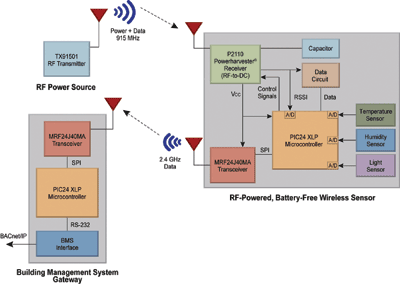Cutting the cord and eliminating battery replacement
BY HARRY OSTAFFE
Vice President of Marketing and Business Development
Powercast
www.powercastco.com
The market growth of low-power wireless devices particularly sensors is driving tremendous interest in using energy sources that can power the devices autonomously. The cost of running wires and the future cost of replacing batteries have discouraged users from widely deploying a verity sensor-based devices.
While solar has been widely used for years to power remote devices, several other types of energy-harvesting approaches have emerged for micro-power applications including vibration, thermal, mechanical, and RF. Of these technologies, RF energy is the only one that can provide either an intentional or ambient power source for wire-free or battery-free applications.
RF energy sources
Ambient RF energy is pervasive, especially from mobile and Wi-Fi networks. ABI Research and IHS iSupply estimate that mobile phone subscriptions has recently surpassed 5 billion, and the ITU estimates there are over 1 billion subscriptions for mobile broadband. Mobile phones represent a large source of transmitters from which to harvest RF energy, and will potentially enable users to provide power-on-demand for a variety of close-range sensing applications. The number of Wi-Fi routers and wireless end-point devices such as laptops is also significant. At short range, such as within the same room, it is possible to harvest a tiny amount of energy (microwatts) from a typical Wi-Fi router transmitting at a power level of 50 to 100 mW. For longer-range operation, antennas with higher gain are needed for practical harvesting of RF energy from mobile base stations and broadcast radio towers. In 2005, Powercast demonstrated ambient RF energy harvesting at 1.5 miles (~2. 4 km) from a small, 5-kW AM radio station. Subsequent demonstrations have included harvesting RF energy from an iPhone in the GSM band and from a nearby mobile base station.
When more power or more predictable energy is needed than what is available from ambient sources, RF energy can be broadcasted in unlicensed frequency bands such as 868 MHz, 915 MHz, 2.4 GHz, and 5.8 GHz. North American regulations limit the output power of radios using certain unlicensed frequency bands to 4 W effective isotropic radiated power (EIRP), as in the case of radio-frequency-identification (RFID) readers typically found in warehouses at loading docks. As a comparison, earlier generations of mobile phones based on analog technology had maximum transmission power of 3.6 W.
RF harvesting receivers
RF-energy-harvesting devices, such as Powercast’s Powerharvester receivers, convert RF energy into dc power. These components are easily added to OEM circuit board designs and work with standard or custom 50-Ω antennas. The RF sensitivity of the P2110 Powerharvester receiver is 11 dBm, making it possible to power devices or charge batteries at distances of 40 to 45 ft line-of-sight from a 3-W transmitter. Improving the RF sensitivity allows for RF-to-dc power conversion at greater distances from a source, but, of course, as the range increases, the available power and rate of charge decreases.
An important performance aspect of an RF-energy harvester is the ability to maintain RF-to-DC conversion efficiency over a wide range of operating conditions, including variations of input power and output load resistance. RF energy harvesting circuits that accommodate multiband or wideband frequency ranges, and automatic frequency tuning, will further increase the power output, potentially expand mobility options, and simplify installation.
Typical applications
Embedded wireless power technology enables products to have improved reliability and extended life cycles by sealing energy from nearby devices to either charge batteries or directly power devices. At close range to a low-power transmitter, this energy can be used to trickle charge a number of devices including GPS or RLTS tracking tags, wearable medical sensors, and consumer electronics such as e-book readers and headsets. At longer range, the power can be used for battery-based or battery-free remote sensors for environmental monitoring and building automation. Depending on the power requirements and system operation, power can be sent continuously, on either a scheduled basis or on-demand.
Available power from a 3-W transmitter will be low milliwatts within a few feet and low microwatts at around 60 ft. Any devices that operate for weeks, months, or years on a single set of batteries are good candidates for wireless recharging using RF energy.
In some applications, simply augmenting the battery life or offsetting the sleep current of a microcontroller is enough to justify adding energy harvesting. A network of transmitters can be positioned in a facility to provide wireless power on a room-by-room basis or to create a many-to-many charging topology. Facility-wide, wireless micropower coverage can be achieved for around $0.12 per square foot. A system block diagram of a implementation of a battery-less sensor system similar to the one recently released by Powercast is shown in Fig. 1 .

A system block diagram for a battery-less sensor system.
Mobile phones hold promise as portable RF energy power sources for a number of batteryless wireless devices. Imagine a mobile phone powering a batteryless, body-worn sensor that sends data to the phone via a Wi-Fi device or Bluetooth. This data can be displayed locally on the handset or transmitted by the phone to a remote monitoring service.
This application has been demonstrated using ambient RF energy from an iPhone (see video at www.RFWirelessSensors.com). Further technology optimization and ecosystem development will make this potential application a commercial reality. ■
Advertisement
Learn more about Powercast





